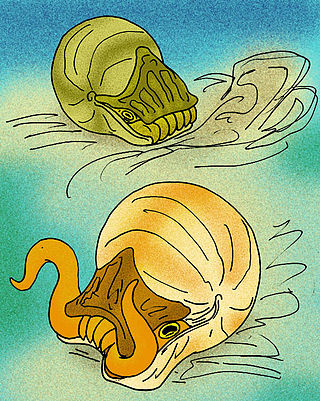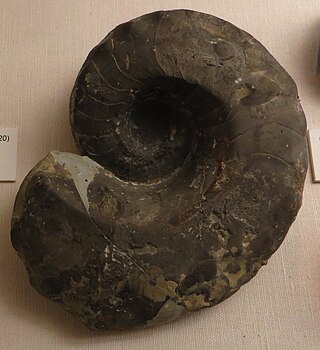
Ammonoids are a group of extinct marine mollusc animals in the subclass Ammonoidea of the class Cephalopoda. These molluscs, commonly referred to as ammonites, are more closely related to living coleoids than they are to shelled nautiloids such as the living Nautilus species. The earliest ammonites appeared during the Devonian, with the last species vanishing during the Cretaceous–Paleogene extinction event.

Goniatites is a genus of extinct cephalopods belonging to the family Goniatitidae, included in the superfamily Goniatitaceae. Hibernicoceras and Hypergoniatites are among related genera.

Acanthohoplites is an extinct genus of ammonites in the family Parahoplitidae that lived in the Aptian and Early Albian stages of the Early Cretaceous.

Arcestes is a genus of extinct ceratitid ammonites found in Triassic-aged marine strata.
Frechites is an early Triassic ammonite, a kind of cephalopod with an external shell, included in the ceratitid family Beyrichitidae.
Ussuria is a genus of Lower Triassic ammonites with a smooth, involute discoidal shell with submonophyllic sutures, belonging to the ceratitid family Ussuriidae.
Sholakoceras is an extinct genus of nautiloid cephalopods from the Lower Permian of southern Russia, included in the Tainoceratacean family Rhiphaeoceratidae,. The shell of Shalakoceras is evolute with a perforate umbilicus. Whorl sections are subquadrate with the ventral and lateral sides flattened and ventral and umbilical shoulders rounded. Lateral areas bear short, slightly oblique ribs. sutures form broad ventral saddles with a slight, shallow lobe, very shallow lateral lobes, and a deep funnel-shaped dorsal lobe.

Titanoceras is an extinct genus in the nautiloid order Nautilida from the Pennsylvanian and Lower Permian of North America and Western Australia.
Syringonautilidae is a family of Nautiloidea from the middle to late Triassic. Syringonautilidae comprise the last of the Trigonoceratoidea and are the source for the Nautilaceae which continued the Nautiloidea through the Mesozoic and into the Cenozoic right down to the recent. Syringonautilidae is a strictly Triassic family, derived early in the Triassic from the Grypoceratidae.

Grypoceratidae is the longest-lived family of the Trigonoceratoidea, or of the near equivalent Centroceratina; members of the Nautilida from the Upper Paleozoic and Triassic.
The Centroceratidae is the ancestral family of the Trigonoceratoidea and of the equivalent Centroceratina; extinct shelled cephalopods belonging to the order Nautilida

Gymnites is a genus of ammonoid cephalopod from the Middle Triassic belonging to the ceratitid family Gymnitidae. These nektonic carnivores lived during the Triassic period, Anisian age.
Biloclymenia is a genus in the ammonoid order Clymeniida which is characterized by a dorsal retrosiphonitic siphuncle with long adapically pointing septal necks.
Falcitornoceras is a goniatitid ammonite from the Late Devonian, early Famennian, that has been found in France and Spain. Falcitornoceras was named by House and Price, 1985, and is the type genus for the subfamily Falcitornoceratinae.

Germanonautilus is a cephalopod genus included in the nautilid family Tainoceratidae, found widespread in the Triassic of North America, Europe, Asia, and north Africa. The shell is a moderately involute nautilicone ; whorl section subquadrate to trapezoidal, widest across the umbilical shoulders, flanks flattened and ventrally convergent, venter flat and wide, dorsum narrowly and deeply impressed. The suture is with broad and deep lateral lobes and a shallow ventral lobe. The siphuncle is central and nummuloidal, composed of expanded segments that give a beaded appearance.
Clypeoceras is a genus of ammonites with an involute discoidal shell from the Lower Triassic.
Eophyllites is a genus of ammonoid cephalopods from the Lower Triassic and a predecessor of genera like Monophyllites and Ussurites.
Palaeophyllites is a genus of ammonoids from the Lower Triassic and a contemporary of the related ussuritid Eophyllites.
Branneroceras is a goniatitid genus from the Late Carboniferous. Their fossils have been found in Nunavut, Canada, and in Arkansas and Texas, USA.
Eowellerites is genus of ammonoid cephalopods belonging to the Welleritidae family. Species belonging to this genus lived in middle Pennsylvanian (Moscovian). Its fossils were found in USA and Japan. It had thinly discoidal shells with a quite wide umbilicus (U/D = 0.3 - 0.5). While in juvenile stages (up to 15 mm in diameter) venter is moderately rounded, it becomes slightly rounded to flattened when becoming mature (100 mm in diameter). 12-lobed suture has adventitious lobe on the first lateral saddle and is also characterized by an addition of an umbilical lobe. Sutural formula is (V1 V1) L1 L (U1 U2): I D. It has evolved from Winslowoceras henbesti and gave rise to genus Wellerites.








